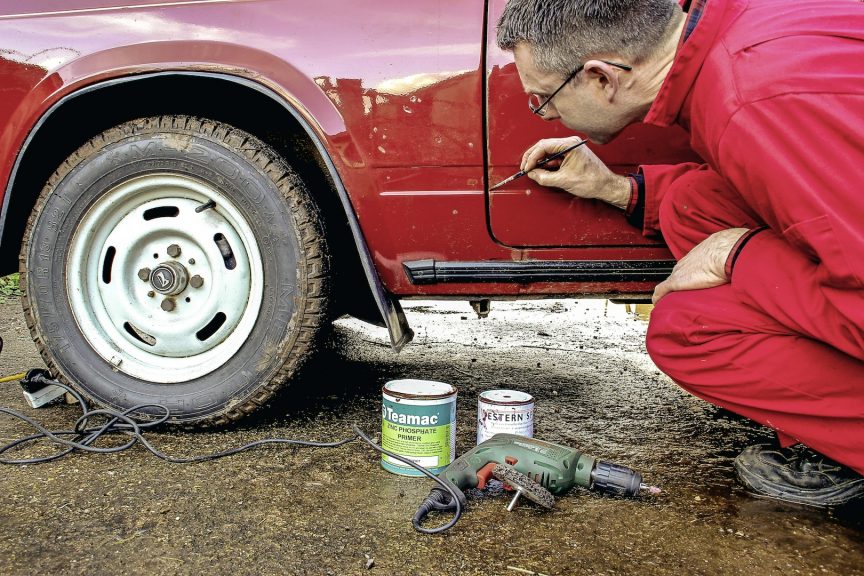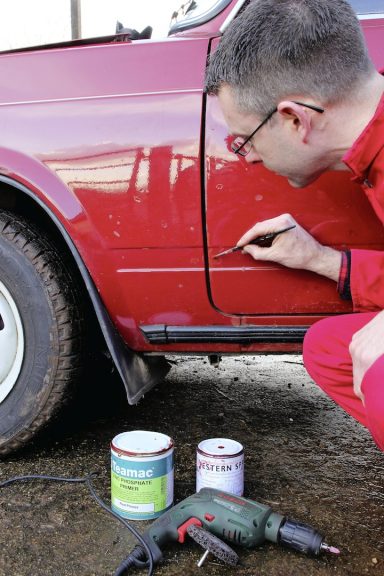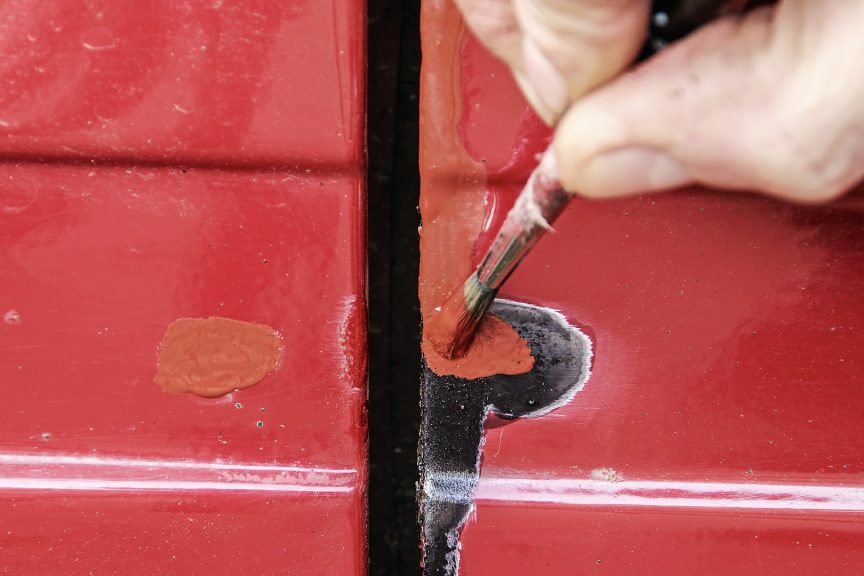 Touching in the damage as you describe will never win any awards for prettiness, but it can do an excellent job of preserving the panels against further rust pitting. You’ll first need to remove the scabby paint and as much of the rust underneath as possible. For the smallest nicks, we’d suggest the tip of a pen-knife. For damage up to about a centimeter in diameter, a small grinding stone in a drill or Dremel works well. For larger areas, use a polycarbide abrasive wheel in a drill or grinder. Note that this will leave tiny scratches in the surrounding paint, so we don’t recommend it for small patches.
Touching in the damage as you describe will never win any awards for prettiness, but it can do an excellent job of preserving the panels against further rust pitting. You’ll first need to remove the scabby paint and as much of the rust underneath as possible. For the smallest nicks, we’d suggest the tip of a pen-knife. For damage up to about a centimeter in diameter, a small grinding stone in a drill or Dremel works well. For larger areas, use a polycarbide abrasive wheel in a drill or grinder. Note that this will leave tiny scratches in the surrounding paint, so we don’t recommend it for small patches.
 Remove rust and paint around the initial damage until you get to sound primer and bright metal. In many cases, you’ll find that rust has eaten deeply into the metal around the center of the damage. It’s not really practical to grind deeply into the panel to chase this out. Leave it for the next stage – a chemical rust remover. There are two basic types: an aggressive phosphoric acid-based confection such as Jenolite, or a safer non-acidic alternative such as Bilt-Hamber Deox-Gel. Apply according to the instructions supplied with the product you’re using.
Remove rust and paint around the initial damage until you get to sound primer and bright metal. In many cases, you’ll find that rust has eaten deeply into the metal around the center of the damage. It’s not really practical to grind deeply into the panel to chase this out. Leave it for the next stage – a chemical rust remover. There are two basic types: an aggressive phosphoric acid-based confection such as Jenolite, or a safer non-acidic alternative such as Bilt-Hamber Deox-Gel. Apply according to the instructions supplied with the product you’re using.
 For good measure, particularly if you’re not convinced that you’ve purged the rust from all nooks and crannies, follow the rust remover with a layer of rust converter such as Rustbuster fe-123 or Bilt-Hamber’s Hydrate 80. Always wipe off excess converter from surrounding paint while it’s wet – it sets rock solid when dry.
For good measure, particularly if you’re not convinced that you’ve purged the rust from all nooks and crannies, follow the rust remover with a layer of rust converter such as Rustbuster fe-123 or Bilt-Hamber’s Hydrate 80. Always wipe off excess converter from surrounding paint while it’s wet – it sets rock solid when dry.
You can now apply primer and colour top coat. A top coat on its own is unlikely to prove weatherproof for long. Use a soft, sable-type artist’s brush for the smallest areas and a 1/4in or 1/2in natural bristle brush for larger areas. Brushing paint can be applied straight from the can, but test first to see if it needs thinning with cellulose or, in the case of polyurethane (synthetic) enamel, white spirit. If you have an aerosol, spray some into the cap of the can and let the thinners evaporate until it’s the right consistency for brushing.
 When the paint has fully hardened (this may be up to a week for synthetic enamels in winter) you can rub it down carefully with a scrap of fine wet-and-dry paper and polish it so that it blends nicely into the surface of the existing paint. If the original paint coat is perilously thin, however, it’s probably best to leave it alone.
When the paint has fully hardened (this may be up to a week for synthetic enamels in winter) you can rub it down carefully with a scrap of fine wet-and-dry paper and polish it so that it blends nicely into the surface of the existing paint. If the original paint coat is perilously thin, however, it’s probably best to leave it alone.
TECH TIP
You can use masking tape to avoid scratching adjacent paint when de-rusting.
My car is fibreglass so no rust issues, but the stone chips are deeper than on metal. Can you recommend a high build primer that I can use before applying top coat?
Hi, would the job be far pleasing to the eye if you went to paint specialist ,made a spray can of car paint and when finishing, paint with spray can, I have done this with excellent results on my e-type , cheers Ron
Probably a stupid question but what is the difference between the Detox Gel and the Hydrate 80? Last year I removed my Triumph 2000 front bumper to install fog lights and whilst there decided to clean up the inside which was full of rust. I rubbed it down removing the worst of the surface rust and then applied two coats of the Hydro 80. This worked really well and looked great. For good measure, I added a coat of the high zinc primer. Should I have also used the Gel after rubbing down the rust? Thanks